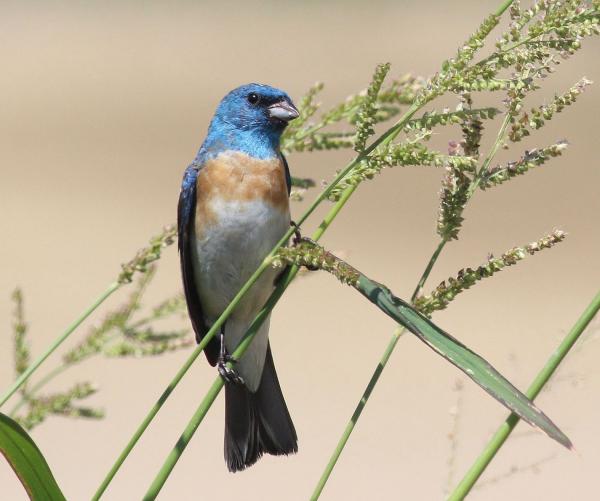
Each week, a percentage of the rare birds reported on the American Birding Association’s Rare Birds Alert are sighted in birder’s yards, usually at their feeding station. Last week, this seemed especially true as a higher percentage of rare birds were being seen through our windows. Are you ready for a rare bird to visit your feeding station? You can increase the chances of attracting a rare bird that passes through your neighborhood by providing a broad-base of food choices and fresh water.
To give you plenty of incentive to keep the idea of attracting a wayward bird into your area of focus, consider that last week, a yearling Bullock’s Oriole, a Western species clearly off-course, was found when it began visiting a hummingbird nectar-feeder in the town of White Pine in the Upper Peninsula of Michigan.
The Third State Record sighting of a Lazuli Bunting in Michigan was a surprise among the American Goldfinches that shared the seed feeders at the famous Whitefish Point Bird Observatory’s gift-shop at the far Northeast-end of the Upper Peninsula.
Another seed-feeder visitor, a beautiful Fourth Provincial Record Painted Bunting, was sighted in the town of Stephensville, Newfoundland.
However, rare backyard birds are not limited to Northern climes: Although a feeding station was not the attractor for a White-throated Thrush in a backyard in Tucson, Arizona, the landscaping probably was attractive for this species that normally ranges from Northern Mexico to Ecuador. Yeah, the backyard habitat made the difference.
Foods for Rare Birds
You never know what kind of bird might fly into your realm of influence, so to improve your chances of attracting a really rare bird, offer a wide variety of foods with fresh water. Keep your feeders stocked — sunflower seeds and nyjer for buntings, finches, and native sparrows; sugar-water nectar for hummingbirds and orioles, fruits including oranges for songbirds, especially orioles, and suet for woodpeckers and a variety of other birds. It’s almost summer, so a no-melt suet is better, and with 149 species attracted to date, the Wild Birds Unlimited’s butter bark suet blend is the best.
Fresh water is the best bet of all to attract the greatest variety of birds, and if you have the sound of water — such as a dripper attached to your birdbath, or a trickling sound in your water feature — that’s how migrating birds find water, and ultimately your feeding station and landscaped bird habitat. Your yard is probably already landscaped with birds in mind, but be sure to check your landscaping regularly — there may be a rare bird using your backyard habitat on its wayward way cross-country.
Next, keep an eye on the ABA Rare Birds article published in each issue of The Birding Wire to keep aware of what feeder birds being seen across North America. It will provide some idea of what birds to watch for and prepare for; and it will get you more inspired about the idea of attracting a rare bird to your yard. Good Luck.










